
Centaurea is a genus of over 700 species of herbaceous thistle-like flowering plants in the family Asteraceae. Members of the genus are found only north of the equator, mostly in the Eastern Hemisphere; the Middle East and surrounding regions are particularly species-rich.
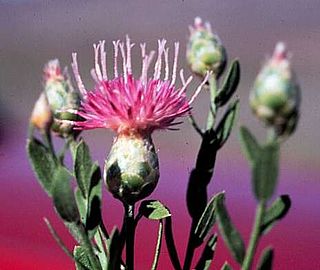
Rhaponticum repens, synonyms including Acroptilon repens and Leuzea repens, with the common name Russian knapweed, is a species of bushy rhizomatous perennial, up to 80 cm tall. Stems and leaves are finely arachnoid-tomentose becoming glabrous and green with age. The rosette leaves are oblanceolate, pinnately lobed to entire, 2–3 cm wide by 3–8 cm long. The lower cauline leaves are smaller, pinnately lobed; the upper leaves become much reduced, sessile, serrate to entire. The heads are numerous terminating the branches. Flowers are pink to purplish, the marginal ones not enlarged. The outer and middle involucral bracts are broad, striate, smooth with broadly rounded tips; the inner bracts are narrower with hairy tips. Pappus present with bristles 6–11 mm long. Fruit is a whitish, slightly ridged achene.
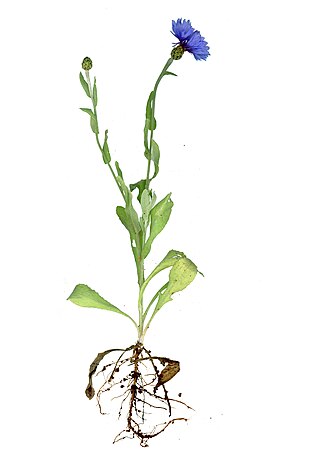
Centaurea cyanus, commonly known as cornflower or bachelor's button, is an annual flowering plant in the family Asteraceae native to Europe. In the past, it often grew as a weed in cornfields, hence its name. It is now endangered in its native habitat by agricultural intensification, particularly by over-use of herbicides. However, Centaurea cyanus is now also naturalised in many other parts of the world, including North America and parts of Australia through introduction as an ornamental plant in gardens and as a seed contaminant in crop seeds.

Centaurea scabiosa, or greater knapweed, is a perennial plant of the genus Centaurea. It is native to Europe and bears purple flower heads.
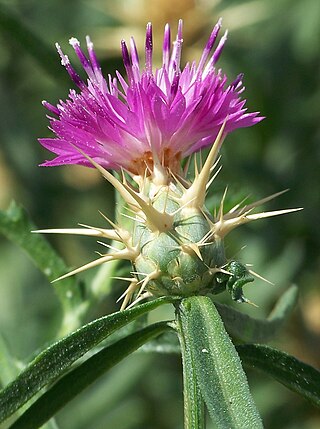
Centaurea calcitrapa is a species of flowering plant known by several common names, including red star-thistle and purple star thistle. It is native to Europe but is rarely found there, it is known across the globe as an introduced species and often a noxious weed. The species name calcitrapa comes from the word caltrop, a type of weapon covered in sharp spikes.

Centaurea solstitialis, the yellow star-thistle, is a species of thorny plant in the genus Centaurea, which is part of the family Asteraceae. A winter annual, it is native to the Mediterranean Basin region and invasive in many other places. It is also known as golden starthistle, yellow cockspur and St. Barnaby's thistle.

Centaurea montana, the perennial cornflower, mountain cornflower, bachelor's button, montane knapweed or mountain bluet, is a species of flowering plant in the family Asteraceae, endemic to Europe. It is widespread and common in the more southerly mountain ranges of Europe, but is rarer in the north. It escapes from gardens readily, and has thereby become established in the British Isles, Scandinavia and North America. This plant has become an invasive species in British Columbia, Canada. Centaurea montana grows in meadows and open woodland in the upper montane and sub-alpine zones, in basic areas. It grows to 30–70 centimetres (12–28 in) tall, and flowers mainly from May to August.

Centaurea melitensis is an annual plant in the family Asteraceae, 1 to 11 decimetres high, with resin-dotted leaves and spine-tipped phyllaries. This plant is native to the Mediterranean region of Europe and Africa. It was introduced to North America in the 18th century; the first documented occurrence in California is in the adobe of a building constructed in San Fernando in 1797. It is also naturalized on a number of Pacific islands.
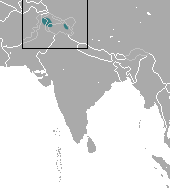
The Kashmir white-toothed shrew is a species of mammal in the family Soricidae. It is found in India and Pakistan.
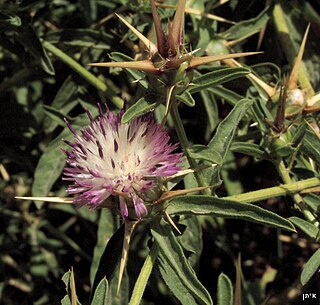
Centaurea iberica, the Iberian knapweed or Iberian star-thistle, is a species of Centaurea. It is native to southeastern Europe and southwestern Asia. It is known elsewhere as an introduced species and a noxious weed.

Centaurea jacea, brown knapweed or brownray knapweed, is a species of herbaceous perennial plants in the genus Centaurea native to dry meadows and open woodland throughout Europe. It grows to 10–80 centimetres (4–31 in) tall, and flowers mainly from June to September. It has simple leaves that are alternate in arrangement.
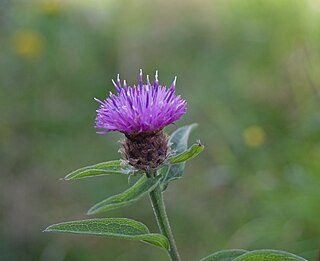
Centaurea nigra is a species of flowering plant in the family Asteraceae known by the common names lesser knapweed, common knapweed and black knapweed. A local vernacular name is hardheads.

Centaurea tchihatcheffii is a species of flowering plant in the family Asteraceae. The flowers are most attractive as the pale or dark pinkish-red marginal florets take on an iridescent shimmer in the sun and wind, hence the vernacular name Yanardöner, meaning ‘iridescent flower’. It flowers from late April to mid-June and in cultivation even earlier, e.g., March in Istanbul. The peak flowering period is mid-May and in earlier years it was sold in some quantity by street florists in Ankara. It is mainly bee-, bug- and beetle-pollinated. Ants play an important role in seed dispersal and the fully ripe fat achenes are a delight for pigeons which settle down to feed in large flocks. The species is of taxonomic interest as it has some rather unusual and unique features not existing in any other Centaurea. For example, the marginal florets are funnel-shaped with crenate margins. The anther-tube is provided with glands at the tips of the appendages.

Aethes smeathmanniana, or Smeathmann's aethes moth, is a moth of the family Tortricidae. It was described by Johan Christian Fabricius in 1781. It is found in most of Europe, Asia Minor and in North America, where it has been recorded from New Jersey and Newfoundland and Labrador.
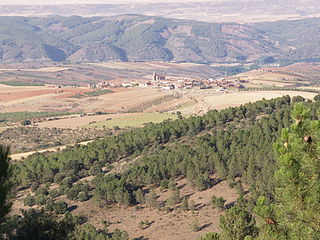
Sierra de Santa Cruz is a mountain range in the Campo de Daroca comarca, Aragon, Spain. It is located north of the Laguna de Gallocanta.
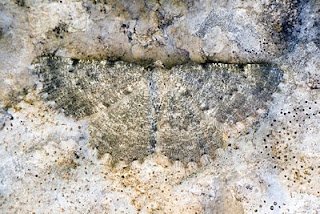
Charissa pullata is a moth of the family Geometridae. It is found in Spain, France, Belgium, Germany, Switzerland, Italy, Slovenia, Austria, the Czech Republic, Poland, Slovakia, Hungary, Romania, Serbia and Montenegro, Bulgaria, North Macedonia, Albania and Greece.

Metzneria metzneriella is a moth of the family Gelechiidae. It is widely distributed throughout Europe, as well as Turkey and southern Siberia. The habitat consists of dry pastures and calcareous soils.
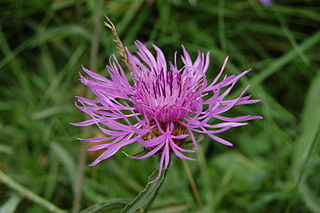
Centaurea aspera, the rough star-thistle, is a species of Centaurea found in Europe and in New York, United States.
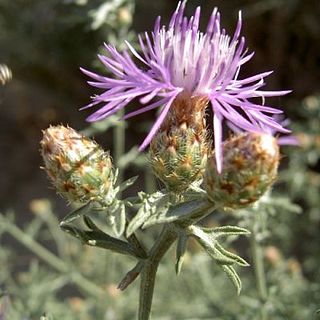
Centaurea paniculata, the Jersey knapweed, is a species of Centaurea found in France and northern Italy.
Conizonia allardi is a species of beetle in the family Cerambycidae. It was described by Léon Fairmaire in 1866. It is known from Tunisia, Algeria, and Morocco. It feeds on Centaurea pullata.



















